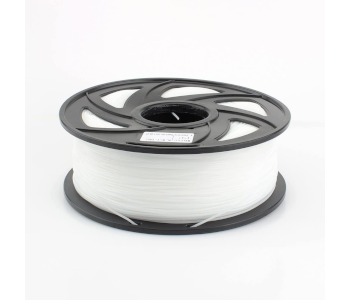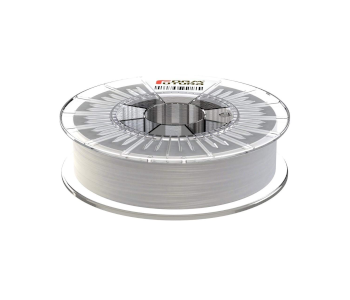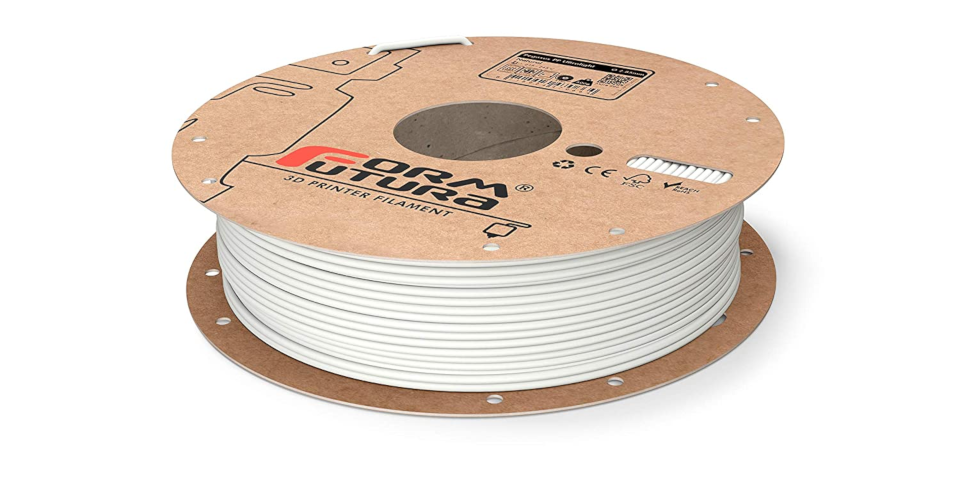Polypropylene Filament: Properties, Applications, and Best Brands
Although FDM is considered the most user-friendly 3D printing technology, it doesn’t always assure an easy and hassle-free experience. For instance, some filament materials are particularly difficult to deal with. Most times, however, these filaments also exhibit some of the best physical and chemical properties.
Polypropylene (PP) filament is one such example. Being one of the most common plastics, you almost certainly have objects made of PP lying around the house or at work. How does PP fare as a 3D printing filament? How is it best used and what are the best brands of PP filament?
What is Polypropylene (PP)?
Polypropylene (PP) is a thermoplastic polymer with a backbone consisting of basic carbon-carbon bonds. It is considered the second-most widely used commodity plastic (second only to polyethylene) because of its high chemical resistance, heat resistance, and overall ruggedness. As of the end of 2019, global estimates place the market for PP products at around $126 billion.
The history of PP dates back to 1951 from the works of two chemists at Philips Petroleum, J. Paul Hogan and Robert Banks. The initial process was refined a few years later by Karl Rehn, a German scientist, to create a crystalline isotactic polymer version of plastic. This upgraded version became the basis for mass production of PP, eventually growing in popularity and application over the next few decades.
Production of PP can be done from either the gaseous form of propene or from a slurry of liquid propene. In either case, the presence of an appropriate catalyst is an essential component of driving forward the polymerization process.
Several types of PP can also be manufactured by introducing additives, such as ethylene. PP with an ethylene additive is considered a type of copolymer, and variations in the level of ethylene may influence properties like the hardness, malleability, and heat resistance of the final product.
Pros and cons of PP filament
As a 3D printing filament, PP hasn’t exactly been a very popular choice. This does not bode well if you were planning on printing with PP filament. It’s a rather complex material but the efforts pay off with superior properties on the finished product.
PROS
Heat-resistant
Like Nylon and ABS, PP prints at fairly high temperatures. This means that prints made with PP filament are suitable for high-temperature applications such as food contact or outdoor exposure. PP is also safe for steam sterilization.
Chemical-resistant
PP is a chemically stable and food-safe material on account of its mostly straight-chain carbon-based chemical structure and saturated bonds. If you have rigid plastic food containers around the house, then there’s a good chance that those are made of PP. While products made from FDM printing may not be entirely suitable for long-term food storage, they can still be used limited food contact
Strong and impact-resistant
PP is a rugged material that is resistant to breakage and repeated stress. When combined with its chemical resistance, this mechanical strength has made PP a material of choice across several industries for pipes, sheets, and large chemical storage tanks. 3D printed products from PP filament make excellent functional parts and prototypes. If you need a replacement part for common household items, PP would be a great choice to make sure that it will last through repeated use.
CONS
Prone to warping
Like fellow high-temperature filaments ABS and Nylon, PP is very prone to warping. This is because of the large and rapid temperature drop that PP filament experiences as soon as it exits the nozzle. PP is particularly problematic because of its semi-crystalline structure, unlike the amorphous plastics like ABS. This means that PP does not follow the usual warping behavior, and you’re pretty going to have to pull out all the stops to deal with PP filament warping.
The significant contraction because of the cooling results in the accumulation of thermal stress, particularly on the corners of the base layer. Although warping is a fairly common problem in 3D printing, PP takes warping to a whole another level.
Poor bed adhesion
Polypropylene has notoriously low surface energy, making it hard to attain good bed adhesion. Fortunately, PP filament sticks well to itself, so layer-to-layer adhesion is not as much of a problem. To succeed with printing PP, you may need to use a bed enclosure and to use appropriate, heat-stable bed adhesion aids.
Applications of PP filament
1. Food contact
The chemical stability of PP makes it an excellent material for projects that are meant to come in contact with food. This includes utensils, serving bowls, and kitchen tools. Just don’t forget that FDM prints will always have surface imperfections that can harbor bacterial growth. If you’re making projects for food contact, make sure to polish them as smooth as possible. Even then, we will not recommend FDM-printed projects for long-term food storage.
2. Medical tools
PP is heat-stable enough to withstand steam sterilization, which makes it suitable for tools to be used in the medical field. A good and timely example would be accessories for face shields and masks which can be thrown into an autoclave before they are reused. The ruggedness of PP also means that these tools can be reused for multiple cycles without losing structural integrity.
3. Functional parts and prototypes
PP is strong and impact-resistant enough to be used widely in industrial settings. 3D printed parts made from PPE can also withstand repeated stress and impact from frequent use. If you need replacement hinges, hooks, or brackets around the house, then PP is a very good material choice. For professionals who need to come up with prototypes, PP should also be one of your go-to materials to create prototypes that not only look great but are also robust and functional.
4. Outdoor items
Exposure to heat and UV radiation are the top two problems encountered when 3D printed parts are exposed to the outdoors. Fortunately, PP is resistant to both. If you need to create signages or other decorative items to be displayed outdoors, then you can pick worse materials than PP.
How to work with PP filament
Before you work with PP, we have to give you a fair warning: it can be one of the most challenging and frustrating materials you’ve ever worked with. There are a lot of good reasons why PP is a very unpopular filament material, along with PE. That does not mean that it’s impossible, but it’s going to take a lot of good planning and numerous failures.
Even if you’ve mastered printing with ABS, making the switch to another high-temperature filament will still require a lot of tweaking of your printer parameters. Oftentimes, it becomes a matter of trial and error until you get results that you’re satisfied with.
Our recommendations here should be a good starting point, but we can’t promise success, as each 3D printer and filament brand will present a unique set of challenges.
To start off, the printing temperature for PP filament should be somewhere between 210 to 230 °C. Starting at the lower range of printing temperatures for the first three layers should help arrest problems with bed adhesion. However, we recommend hitting higher printing temperatures for the succeeding layers to help improve layer-to-layer adhesion. Hitting the maximum of 230 °C is ideal as long as no stringing problems are encountered.
A heated bed is absolutely necessary when printing with PP filament. A range of 85 to 100 °C for the bed temperature is generally recommended, but we’ve also heard of users setting their bed to temperatures as high as 150 °C. While higher temperatures may help reduce the thermal stress on the print’s base layer, you must be careful not to reach a point where the adhesive you applied to the bed starts to break down.
Bed adhesion is quite challenging when it comes to PP filament, as there really isn’t the best choice. The usual glue stick and hairspray just aren’t sticky enough. Instead, most users apply a layer of packaging tape on the heated build plate. The problem with this approach is that packaging tape can start to break down at temperatures close to 100 °C, so you’ll have to be very careful in managing your bed temperature.
Conversely, you can use the concept of similar materials sticking incredibly well with each other and buy a specially design polypropylene build plate. This custom build plate can be affixed to your build platform like a glass bed. Just remember to go through your standard leveling process once it has been installed.
If you’re still experiencing bed adhesion problems despite these bed adhesion solutions, another solution is to print with a raft. A raft is basically a sacrificial base layer that will sit below your actual base layer. This will serve to provide a surface to which your print will adhere to and should stave off any warping problems. However, removing a raft can be difficult and the finish of your print’s bottom layer will almost certainly suffer.
Another requirement for printing with PP is a bed enclosure. This will help maintain an elevated temperature in your build platform, slowing down the cooling process to help enhance bed adhesion and layer adhesion. If you’re using a DIY bed enclosure, make sure that your printer’s electrical components are also rated for elevated temperatures.
Printing at high speeds is generally recommended for PP filament. This helps reduce the effects of warping due to rapid cooling and improves layer-to-layer adhesion. A range of 35 to 60 mm/s should suffice. Start at the lower range for the first three layers to establish the base layers then gradually increase the print speed until you reach the maximum or until you start seeing stringing problems.
As you would expect, no cooling is recommended for PP.
If you’ve done every measure to get your base layer to stick to the build platform, you should also anticipate the removal of the finished print to be problematic. PP filament tends to “fuse” readily with the print bed, especially when printed at high temperatures. We find that the best way to avoid this problem is to print with a raft, then smooth out the bottom layer later on by sanding.
Best brands of PP filament
Another consequence of PP filament not being very popular in the 3D printing community is the fact that not many filament brands sell it. If you can find one that’s on stock, it would probably be quite expensive on account of its rarity. What this implies is that printing with PP filament is kind of a big commitment, so make sure you’re up to it before you click that Buy button.
1. Gizmo Dorks Polypropylene Filament

For our top recommendation, we would have to go with popularly reliable brand Gizmo Dorks. Their white PP filament comes in a 1-kilogram spool with a 1.75-mm. diameter. We like how Gizmo Dorks churns out high-quality filaments with consistent diameters, as we certainly wouldn’t want to run into more unnecessary problems when printing with PP.
While the product is good, it doesn’t mean that it’s going to be easy to print with. This is no fault of the filament maker – PP is just an insanely difficult filament to handle. For what it’s worth, the consistent filament quality, color, and size are enough good points in our book.
2. CREOZONE Premium Quality PP Filament

Another fairly popular choice is this premium PP filament from CREOZONE. What makes this filament ‘premium?’ We’re not sure either, but it is fairly expensive. As with the Gizmo Dorks filament, we appreciate the consistency of the filament in terms of size and color. CREOZONE also promises that their filaments are free of bubbles. Although these are all baseline quality standards, they sure are welcome in a filament material like PP.
3. Pegasus PP Ultralight Filament

Pegasus takes a different route with their PP filament by designing it to be ‘ultralight.’ This means that their PP filament is 20% lighter than the average PP filament, a feat they achieved using nanotechnology. This should translate to a finished 3D printing project with similarly low density.
Theoretically, having less of the material being extruded should reduce the shrinkage problems inherent to PP. How well theory translates to practice remains to be seen. At more than $100, for a 1-kilogram spool of filament, however, we find it hard to imagine 3D printing enthusiasts who haven’t tried printing with PP before buying this product. If you’re a bit more confident in your PP wrangling skills, then this filament may be worth a shot.
The roundup
| Material | Polypropylene (PP) filament |
| Properties | Heat-resistant, chemically stable, impact-resistant, prone to warping and shrinkage, poor layer adhesion |
| Applications | Medical tools, functional parts, and prototypes, tools for food contact, outdoor signages and decors |
| Printing temperature | 210 to 230 °C; start at low values for the first three layers and gradually increase to max value |
| Bed temperature | 85 to 100 °C |
| Bed adhesion | Packaging tape, PP or HDPE build platform or print with a raft |
| Print speed</strong | 35 to 60 mm/s; start at low values for the first three layers and gradually increase to max value |
| Cooling | No cooling throughout the whole printing process; instead, a bed enclosure is recommended |
Despite how common PP as a plastic is, it’s a rarely used material for 3D printing. Aside from an exceptionally high tendency to shrink, its semi-crystalline structure also means that it warps with a behavior that is different from ABS or Nylon. Even if you’ve worked with other high-temperature filaments before, PP can prove to be quite a handful.
If you plan to work with PP filament for the first time, then our best piece of advice is to plan accordingly and be patient. Have alternatives in case something goes wrong, and it would be wise to go back to the fundamentals of 3D printing to figure out a solution.
If you can manage to master printing with PP, though, then you can add one of the best plastics to your repertoire. Bar none, PP is one of the best industrial-grade plastics and will certainly prove to be useful across several applications.


